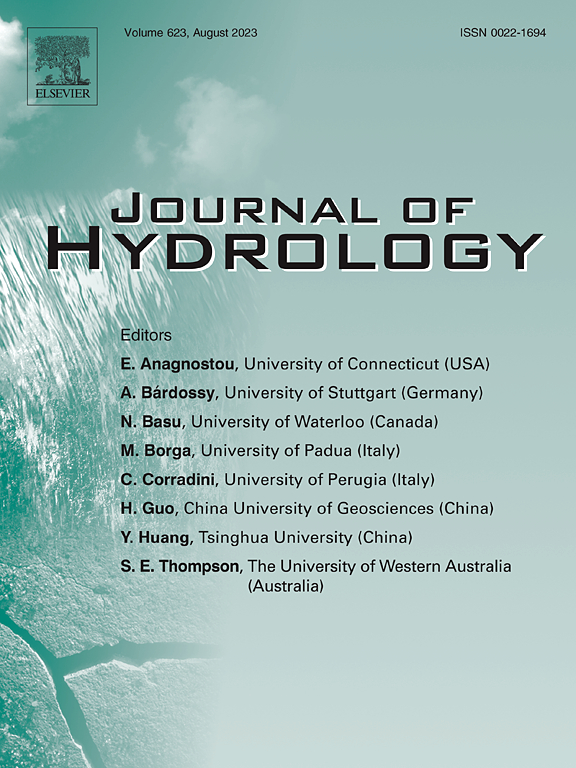Enhancing climate projections via machine learning: Multi-model ensemble of precipitation and temperature in the source region of the Yellow River
IF 6.3
1区 地球科学
Q1 ENGINEERING, CIVIL
引用次数: 0
Abstract
Accurately estimating future variations in precipitation and temperature in the Source Region of the Yellow River (SRYR) is critical, given its key role as the water conservation area of the Yellow River basin in China. To enhance the accuracy of regional climate projections, this study proposes a machine learning-enhanced ensemble framework comprising global climate model (GCM) selection, bias correction, and multi-model ensemble, effectively combining physical climate modeling with data-driven methods. Specifically, a rank score method was used to evaluate the performance of 22 GCMs from the Coupled Model Intercomparison Project Phase 6 (CMIP6) in reproducing precipitation and temperature over the SRYR. Based on this assessment, six top-performing GCMs were selected and subsequently bias-corrected. To determine the most effective ensemble strategy, four multi-model ensemble approaches—including weighted averaging (WA), random forest (RF), feedforward neural network (FNN), and long short-term memory (LSTM)—were employed to integrate the bias-corrected outputs from the selected models over the historical period. All ensemble approaches outperformed individual GCMs in reproducing historical climate variability, as evaluated by the Pearson correlation coefficient (r) and Nash–Sutcliffe efficiency (NSE). Among them, the LSTM method exhibited the highest overall accuracy and best capability in capturing temporal variability, and was thus selected to integrate future precipitation and temperature projections under the three Shared Socioeconomic Pathways (SSPs). Projections under the SSP1–2.6, SSP2–4.5, and SSP5–8.5 scenarios indicate that both precipitation and temperature will rise relative to the baseline period (1979–2014), with the strongest increases under SSP5–8.5. Winter precipitation exhibits the most pronounced seasonal increase, while seasonal differences in temperature rise are less distinct, with slightly stronger warming in winter. The machine learning–enhanced ensemble framework proposed in this study improves regional climate projections and provides a practical tool for guiding hydrological impact assessments and climate adaptation strategies in alpine basins.
通过机器学习增强气候预测:黄河源区降水和温度的多模式集合
鉴于黄河源区作为中国黄河流域的关键水源,准确估算其未来降水和温度变化至关重要。为了提高区域气候预测的准确性,本研究提出了一个机器学习增强的集成框架,包括全球气候模式(GCM)选择、偏差校正和多模式集成,有效地将物理气候建模与数据驱动方法相结合。具体而言,采用秩分法对耦合模式比对项目第6阶段(CMIP6)的22个gcm在再现SRYR降水和温度方面的性能进行了评价。在此评估的基础上,选择了六个表现最好的gcm,并随后进行了偏差纠正。为了确定最有效的集成策略,采用加权平均(WA)、随机森林(RF)、前馈神经网络(FNN)和长短期记忆(LSTM)四种多模型集成方法对历史时期所选模型的偏差校正输出进行集成。通过Pearson相关系数(r)和Nash-Sutcliffe效率(NSE)评估,所有集合方法在再现历史气候变率方面都优于单个gcm。其中,LSTM方法整体精度最高,捕获时间变率的能力最好,因此被选择用于整合三种共享社会经济路径(ssp)下的未来降水和温度预测。SSP1-2.6、SSP2-4.5和SSP5-8.5情景下的预估表明,相对于基准期(1979-2014),降水和温度都将上升,其中SSP5-8.5情景下的增幅最大。冬季降水的季节性增加最为明显,而气温上升的季节差异不太明显,冬季增温略强。本研究提出的机器学习增强集成框架改进了区域气候预测,为指导高寒流域水文影响评估和气候适应策略提供了实用工具。
本文章由计算机程序翻译,如有差异,请以英文原文为准。
求助全文
约1分钟内获得全文
求助全文
来源期刊

Journal of Hydrology
地学-地球科学综合
CiteScore
11.00
自引率
12.50%
发文量
1309
审稿时长
7.5 months
期刊介绍:
The Journal of Hydrology publishes original research papers and comprehensive reviews in all the subfields of the hydrological sciences including water based management and policy issues that impact on economics and society. These comprise, but are not limited to the physical, chemical, biogeochemical, stochastic and systems aspects of surface and groundwater hydrology, hydrometeorology and hydrogeology. Relevant topics incorporating the insights and methodologies of disciplines such as climatology, water resource systems, hydraulics, agrohydrology, geomorphology, soil science, instrumentation and remote sensing, civil and environmental engineering are included. Social science perspectives on hydrological problems such as resource and ecological economics, environmental sociology, psychology and behavioural science, management and policy analysis are also invited. Multi-and interdisciplinary analyses of hydrological problems are within scope. The science published in the Journal of Hydrology is relevant to catchment scales rather than exclusively to a local scale or site.
 求助内容:
求助内容: 应助结果提醒方式:
应助结果提醒方式:


